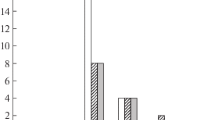Abstract
Tilorone hydrochloride, an interferon inducer in small laboratory animals, was demonstrated to elicit formation of macrophage migration affecting and microbial growth inhibitory cytokines after peroral drug administration to mice. Serum kinetics of the migration inhibitory cytokine resembled those of interferon, exhibiting a peak after about 24 h, whereas the bactericidal cytokine showed a steady increase up to 48 h after drug treatment. Both the factors were found to have molecular weights of 10,000–30,000 daltons as determined by Sephadex G-200 chromatography, to be stable at pH 2 and at 56°C for 30 min, sensitive to chymotrypsin and resistant to RNase digestion. The migration enhancing serum activity could not finally be characterized so far. The physicochemical data are discussed in comparison to those of lymphocyte-derived cytokines. It is suggested that cytokine production may be, at least partially, responsible for the immunological effects of tilorone and possibly contribute to its antiviral action.
Similar content being viewed by others
References
B.B. Bloom,Elaboration of Effector Molecules by Activated Lymphocytes, in:Mediators of Cellular Immunity (Eds. H.S. Lawrence and M. Landy; Academic Press, New York-London, 1969), pp. 247–262.
D.L. Cahall andG.P. Youmans,Conditions for Production, and some Characteristics, of Mycobacterial Growth Inhibitory Factor Produced by Spleen Cells from Mice Immunized with Viable Cells of the Attenuated H37Ra Strain of Mycobacterium Tuberculosis, Infect. Immunity12, 833–840 (1975).
D.L. Cahall andG.P. Youmans,Molecular Weight and Other Characteristics of Mycobacterial Growth Inhibitory Factor Produced by Spleen Cells Obtained from Mice Immunized with Viable Attenuated Mycobacterial Cells, Infect. Immunity12, 841–850 (1975).
P. Chandra,Molecular Approaches for Designing Antiviral and Antitumor Compounds, Top. Curr. Chem.52, 99–139 (1974).
S. Cohen, P.E. Bigazzi andT. Yoshida,Similarities of T Cell Function in Cell-Mediated Immunity and Antibody Production, Cell. Immunol.12, 150–159 (1974).
P. Cuatrecasas andC.B. Anfinsen,Affinity Chromatography, in:Methods in Enzymology, vol. 22 (Ed. W.B. Jacoby; Academic Press, New York-London, 1971), p. 345.
J.R. David andR. David,Assay for Inhibition of Macrophage Migration, in:In Vitro Methods in Cell-Mediated Immunity (Eds. B.R. Bloom and P.R. Glade; Academic Press, New York-London, 1971), pp. 249–258.
E. DeClerq,Synthetic Interferon Inducers, Top Curr. Chem.52, 173–208 (1974).
E. DeClerq andT.C. Merigan,Bis-DEAE-Fluorenone: Mechanism of Antiviral Protection and Stimulation of Interferon Production in the Mouse, J. Infect. Dis.123, 190–199 (1971).
T. Diamantstein,Stimulation of Humoral Immune Response by Tilorone Hydrochloride, Immunology24, 771–775 (1973).
L.B. Epstein, M.J. Cline andT.C. Merigan,The Interaction of Human Macrophages and Lymphocytes in the Phytohemagglutinin-Stimulated Production of Interferon, J. Clin. Invest.50, 744–753 (1971).
K.H. Fantes,Purification and Physico-Chemical Properties of Interferons, in:Interferons and Interferon Inducers (Ed. N.B. Finter; North-Holland Publishing Company, Amsterdam-London, 1973), pp. 171–200.
T.D. Flanagan, T. Yoshida andS. Cohen,Production of Macrophage Migration Inhibition Factors by Virus-Infected Cell Cultures, Infect. Immunity8, 145–150 (1973).
R.A. Fox, D.S. Gregory andJ.D. Feldman,Migration Inhibition Factor (MIF) and Migration Stimulation Factor (MSF) in Fetal Calf Serum, J. Immunol.112, 1861–1866 (1974).
W. Friedrich, S. Lazary, C. Geczy andA.L. DeWeck,Lymphokines. I. Use of Insoluble Concanavalin A for the Production of Migration Inhibitory Factor in Guinea Pig Lymphocyte Cultures, Int. Arch. Allergy49, 504–518 (1975).
A. Geraldes, Ed.,Effects of Interferon on Cells, Viruses and the Immune System (Academic Press, London-New York-San Francisco, 1975).
J.P. Gibson, H. Megel, K.P. Camyre andJ.G. Michael,Effect of Tilorone Hydrochloride on the Lymphoid and Interferon Responses of Athymic Mice, Proc. Soc. Exp. Biol. Med.151, 264–266 (1976).
D.J. Giron, J.P. Schmidt andF.F. Pindak,Tilorone HCl: Lack of Correlation Between Interferon Induction and Viral Protection, Antimicrob. Ag. Chemother.1, 78–79 (1972).
R. Gruenewald andS. Levine,Effect of Tilorone on Susceptibility of Mice to Primary or Secondary Infection with Listeria Monocytogenes, Infect. Immunity13, 1613–1618 (1976).
R.F. Krueger andG.D. Mayer,Tilorone Hydrochloride: an Orally Active Antiviral Agent, Science169, 1213–1214 (1970).
A.L. Kühner andJ.R. David,Partial Characterization of Murine Migration Inhibitory Factor (MIF), J. Immunol.116, 140–145 (1976).
B. Mauersberger, W. Witzleb, G. Heder, S. Schnitzler, R. Richter, W. Jacob, K.-D. Jentzsch andG. Kambach,Charakterisierung einer Sublinie von L-Zellen (Klon L-MK), Acta Biol. Med. Germ. (in press).
G.D. Mayer andR.F. Krueger,Tilorone Hydrochloride: Mode of Action, Science169 1215–1216 (1970).
H. Megel, A. Raychaudhuri, S. Goldstein, C.R. Kinsolving, I. Shemano andJ.G. Michael,Tilorone: its Selective Effects on Humoral and Cell-Mediated Immunity, Proc. Soc. Exp. Biol. Med.145, 513–518 (1974).
A.E. Munson, J.A. Munson, W. Regelson andG.I. Wampler,Effect of Tilorone Hydrochloride and Congeners on Reticuloendothelial System, Tumors, and the Immune Response, Cancer Res.32, 1397–1403 (1972).
H.G. Remold,Requirement for α- l -Fucose on the Macrophage Membrane Receptor for MIF, J. Exp. Med.138, 1065–1076 (1973).
R.E. Rocklin, H.G. Remold andJ.R. David,Characterization of Human Migration Inhibitory Factor (MIF) from Antigen-Stimulated Lymphocytes, Cell. Immunol.5, 436–445 (1972).
S.B. Salvin, J. Nishio andJ.T. Shonnard,Two New Inhibitory Activities in Blood of Mice with Delayed Hypersensitivity, after Challenge with Specific Antigen, Infect. Immunity9, 631–635 (1974).
A. Trudgett,Partial Purification of Lymphokine Activities by Iso-electric Focusing, J. Immunol. Meth.10, 1–6 (1976).
R.H. Weisbart, R. Bluestone, L.S. Goldbberg andG.M. Pearson,Migration Enhancement Factor: a New Lymphokine, Proc. Nat. Acad. Sci. USA71, 875–879 (1974).
W. Zschiesche, E. Slavina andI. Leipunskaya,Effect of Tilorone Hydrochloride on Graft-Versus-Host (GvH) Reaction in Mice, Acta Biol. Med. Germ.36, 107–112 (1977).
Author information
Authors and Affiliations
Rights and permissions
About this article
Cite this article
Zschiesche, W., Fahlbusch, B., Schumann, I. et al. Induction of cytokines by tilorone hydrochloride. Agents and Actions 8, 515–522 (1978). https://doi.org/10.1007/BF02111439
Received:
Issue Date:
DOI: https://doi.org/10.1007/BF02111439




